Chances are that the International Sweethearts of Rhythm or Ina Ray Hutton and Her Melodears will never be subject to the perpetual nostalgia-tripping that the Glenn Miller Band enjoys. Kay D. Ray (left), with the film's narrator, Patrice Rushen. For one thing, the tributes would come too late, and they would probably be seen as sexist. But, as Kay D. Ray 's 80-minute documentary, "Lady Be Good: Instrumental Women in Jazz," makes clear, a lot of big-band history involved all-female ensembles, and along the way, there were many individuals who demonstrated that women on the bandstand shouldn't be restricted to their warbling sex appeal. The film was shown at Central Library Monday afternoon, preceded by an appetizing mini-set by the Monika Herzig Quartet. With the tireless advocate for jazz in Central Indiana and women's contributions to it at the keyboard, the group was capably filled out by Amanda Gardier, alto sax; Jennifer Kirk, bass, and Arianna













